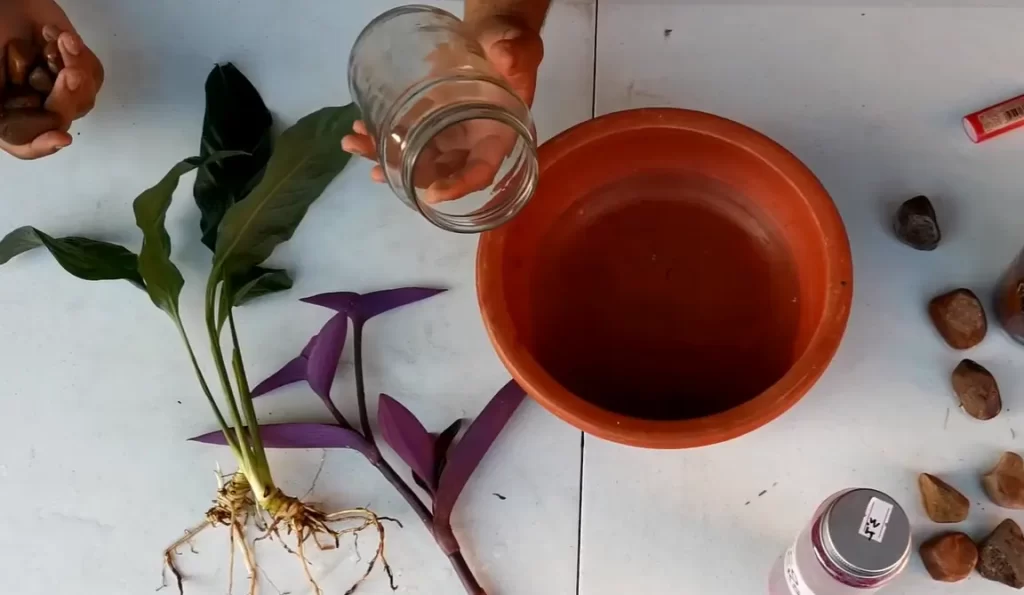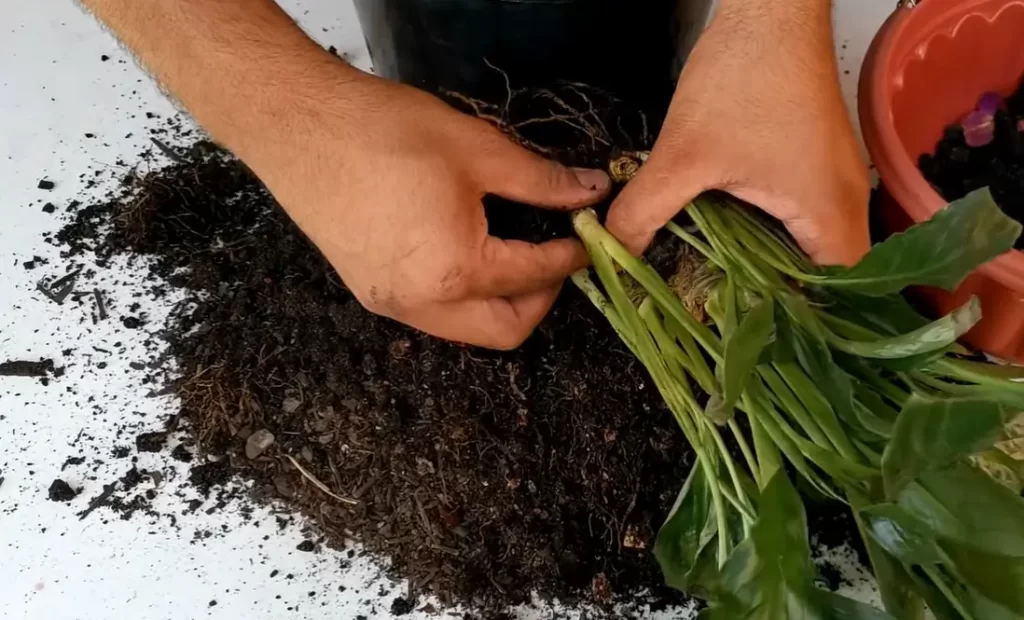What Peace Lily Root Rot Look Like: Find Out!
In the world of houseplants, the peace lily is a favorite among many. Its lush green foliage and delicate white flowers add an element of tranquility to any space.
However, like all living things, peace lilies are susceptible to certain ailments, and one of the most common is root rot. If left unchecked, root rot can quickly take over the plant and cause irreversible damage.
But what does peace lily root rot look like? Peace lily root rot looks like brown, mushy, and decaying roots. The leaves may yellow, wilt, and droop, and the plant may lose vigor.
In this blog, we will explore what root rot looks like in peace lilies and offer tips on preventing and treating this common condition.
What is Peace Lily Root Rot?
Peace Lily Root Rot is a common condition affecting Peace Lilies, a popular houseplant. It is caused by overwatering and poor drainage, which lead to soggy soil, and damage to the roots. The symptoms include yellow leaves, wilted foliage, and stunted growth.

To diagnose the problem, gently remove the plant from the pot and examine the roots for signs of rot, such as mushy, brown, or black roots. The solution is to repot the plant in fresh, well-draining soil, prune any damaged roots, and reduce watering.
Preventive measures include ensuring the pot has adequate drainage holes, avoiding overwatering, and placing the plant in an environment with indirect light and temperatures between 60-75 °F.
However, peace lilies do like coffee grounds. You may be surprised! Well, check the content on “do peace lilies like coffee grounds?” to get detailed information.
Causes of Root Rot in Peace Lilies
Root rot is a fungal disease affecting the plant’s roots and eventually killing the entire plant. Here, we will discuss the causes of root rot in peace lilies and how to prevent and treat it.
Overwatering
Overwatering is one of the main causes of root rot in peace lilies. When the plant is watered too frequently or with too much water, the soil becomes saturated, and the roots become waterlogged. This creates an environment where fungi can thrive and attack the roots, causing them to rot.
Poor Drainage
Peace lilies require well-draining soil to prevent water from accumulating around the roots. If the potting soil does not have proper drainage, excess water can pool around the roots, leading to root rot. Ensure your pot has drainage holes, and use a soil mix that provides adequate drainage.
Fungal Infections
Fungal infections are another cause of root rot in peace lilies. Fungi can enter the plant through damaged roots or wounds and quickly spread throughout the plant, causing extensive damage. These infections often occur in damp or humid environments, making peace lilies susceptible to fungal diseases.
Pests and Diseases
Pests and diseases can also damage the roots of peace lilies, making them vulnerable to root rot. Insects such as spider mites and mealybugs can damage the roots, as can diseases such as Phytophthora and Pythium.
What Does Peace Lily Root Rot Look Like?
Peace lilies are a popular indoor plant that can thrive in low-light conditions. However, they are susceptible to root rot, a common fungus disease that affects many houseplants. Here are some symptoms to look for if you suspect your peace lily has root rot.
Yellowing Leaves
One of the first signs of peace lily root rot is yellowing leaves. The leaves may turn yellow and become limp or wilted. Due to damaged roots, the plant can no longer take up water and nutrients from the soil.
Brown and Mushy Roots
The roots of a peace lily with root rot will be brown and mushy. If you gently tug the plant, it may also come out of the soil easily. Healthy roots should be firm and white.
Foul Odor
Another sign of root rot is a foul odor from the soil. This odor is caused by the fungus that breaks down the plant’s roots.
How to Prevent Peace Lily Root Rot
Root rot is a fungal disease that occurs when the soil remains too wet, causing the roots to rot and the plant to wilt. Here, we will discuss some preventative measures to avoid peace lily root rot.
Proper Watering Technique
One of the main causes of root rot is overwatering. To prevent root rot in your peace lily, make sure you are watering the plant properly. Water the plant only when the soil is dry to the touch.
When you water, do not let the plant sit in standing water. Instead, water until the water drains out the bottom of the pot, and then empty the saucer underneath.
Adequate Drainage
Proper drainage is essential to prevent root rot. When planting your peace lily, ensure the pot has drainage holes in the bottom. This will allow excess water to drain out of the soil, preventing it from becoming waterlogged.
Appropriate Pot Size
The size of the pot you use for your peace lily can also impact its likelihood of developing root rot. Ensure you choose a pot that is appropriate for the size of your plant.
The soil may retain too much water if the pot is too large, leading to root rot. If the pot is too small, the plant may become root-bound, which can also cause problems.
Good Air Circulation
Good air circulation can help prevent root rot by allowing the soil to dry out more quickly. Ensure your peace lily is not placed in a location where air circulation is poor, such as a corner or a closet. If you have multiple plants, ensure they are not overcrowded, which can also limit air circulation.
Soil Quality
Using high-quality soil can also help prevent root rot. Choose a well-draining potting mix that is appropriate for your peace lily. Some people add perlite or sand to the soil to increase its drainage capacity.
Regular Inspections
Regularly inspecting your peace lily can help you catch root rot early before it becomes a serious problem. Look for signs such as yellowing leaves, wilting, and a foul odor from the soil. If you notice any of these signs, take action immediately to prevent further damage.
Treatment of Peace Lily Root Rot
Peace lilies is popular indoor plants that are relatively easy to care for. However, these plants are prone to root rot if they are overwatered or if their soil does not drain well.

Here are some steps to treat peace lily root rot:
- Remove the Plant From its Pot: Gently remove the plant from its pot and inspect the roots. If the roots are brown, mushy, or have a foul odor, they are likely rotting.
- Remove Affected Roots: Use a clean pair of scissors or pruning shears to cut off soft, brown, or black root slack. Be careful not to damage the healthy roots.
- Clean the Roots: Rinse the roots under running water to remove any remaining soil or debris.
- Repot the Plant: Choose a new pot that is slightly larger than the old one and has good drainage. Fill the bottom of the pot with a layer of gravel or small stones to improve drainage. Then, add fresh potting soil and place the plant in the new pot, ensuring the roots are covered with soil.
- Water the Plant: Water the plant sparingly, allowing the soil to dry out slightly between watering. Be careful not to overwater the plant, which can lead to root rot.
- Monitor the Plant: Monitor the plant for any signs of stress, such as wilting or yellowing leaves. If you notice any problems, take action immediately.
Final Words
The discussion above has highlighted: What does peace lily root rot look like? Root rot is a common issue with peace lilies, caused by poor drainage and overwatering.
It can be identified by the wilting of the leaves, yellow or brown discoloration, and a mushy texture to the roots. Additionally, the presence of mold can be an indicator of root rot.
To avoid root rot, you should ensure that the soil drains well and that the peace lily is not overwatered. Proper care is essential for a healthy and vibrant peace lily.
